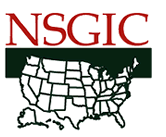
 The
purpose of NSGIC is "to encourage
effective and efficient government through the coordinated development
of geographic information and technologies to ensure that information may
be integrated at all levels of government." True to its purpose, NSGIC
is pursuing some exciting initiatives to support member states and promote
the National Spatial Data Infrastructure.I'll talk about two of those
that support member states in their individual initiatives to inventory
GIS activities and coordinate multi-jurisdictional levels of government
- RAMONA and NSGIC's State Coordination Model and Success Measures.
The
purpose of NSGIC is "to encourage
effective and efficient government through the coordinated development
of geographic information and technologies to ensure that information may
be integrated at all levels of government." True to its purpose, NSGIC
is pursuing some exciting initiatives to support member states and promote
the National Spatial Data Infrastructure.I'll talk about two of those
that support member states in their individual initiatives to inventory
GIS activities and coordinate multi-jurisdictional levels of government
- RAMONA and NSGIC's State Coordination Model and Success Measures.
RAMONA
As part of NSGIC's efforts to provide resources and coordination mechanisms,
we are proposing a project we're currently calling RAMONA, which stands
for "Random Access Metadata tool for Online National Assessment."
The Issue
With considerable time, effort and expense, there have been numerous
Federal- and state-sponsored efforts to inventory the geospatial data holdings
of state and local government.All of these have been "snap-shots" that
have not been designed to meet the needs of the entire geospatial community
today or in the foreseeable future.
The Solution
NSGIC proposes to change this paradigm and build a national inventory
system that can meet the needs of the entire geospatial community.In 1997-98,
NSGIC conducted a successful National Framework Survey that provided a
clear picture of the framework data holdings across the nation.Maximizing
that experience and complimentary efforts since then, NSGIC will develop
a national-level, state-based inventory of geospatial data, policies and
technology to replace the multitude of state and federal survey efforts
with a consistent, locally implemented living inventory.
The inventory instrument will be designed as a web-based tool with dynamic functionality, such as automatic metadata generation, status maps, reporting functions and "Rolodex®-like" applications.It will address the common information elements based on stakeholder needs, including status of GIS programs, platforms, connectivity, policy issues, data, and issues assessment. The product will be made available to all national interests and NSGIC State Coordinators will implement its use through local coordination efforts.
As envisioned, RAMONA builds on the cooperative work of a number of NSGIC states.In 2002, the Maryland State Geographic Information Committee (MSGIC) developed a survey instrument to incorporate the needs of over seven separate Federal- and state-based inventory efforts underway in the state.Part of its design was based on the North Carolina survey instrument developed for its own flood map modernization program.At about the same time, the Indiana Geographic Information Council continued to build on the North Carolina and Maryland survey efforts and initiated development of a dynamic web-based inventory tool that was designed for maintenance over an indefinite period.Indiana's system incorporates useful administrative tools, "Rolodex®-like" functions and status maps in addition to the data inventory.It provides a good example of "living survey" that can be maintained in perpetuity.
The objectives for RAMONA are as follows:
- Provide the Nation with a powerful system that will be readily used by federal, state and local governments, the NSDI community and the private sector, to continuously update and inventory geospatial data and policies, because it provides substantial benefits in return for keeping the system updated.
- Eliminate duplication of effort at state and federal levels that are related to surveys of geospatial data and policies.
- Provide an open architecture and server protocol that will allow any entity to easily write a custom "wrapper" to meet their particular needs while ensuring that there is a nationally consistent database.
- Deliver RAMONA as a functional system within one year of project initiation if adequate funding is secured.
It is our belief that a dynamic, "living tool" that is national-level
and state-based can meet the needs of the entire geospatial community and
make expensive, discreet inventories a thing of the past.NSGIC is seeking
federal funding assistance to make RAMONA a reality.A proposal has been
submitted to NOAA for support of the initial requirements stage of the
RAMONA project.
State Coordination Model and Success Measures
NSGIC is an advocate for the development of a National Spatial Data
Infrastructure (NSDI), which includes the technology, policies, standards,
human resources and related activities necessary to acquire, process, distribute,
use, maintain and preserve geospatial data.The NSDI is reliant on effective
multi-jurisdictional, geospatial coordination in each state.
Earlier in 2003 at the NSGIC mid-year conference, state representatives gathered to complete a shared vision for geospatial coordination at the state level.This vision first outlined success measures that would demonstrate if a state is successful at geospatial coordination.The group further articulated specific coordination criteria that could be documented which would lead to successes.
The following are lists of critical factors for measuring performance objectives and the criteria needed for an effective statewide coordination program.Items featured in the lists are intended as guidelines for states to consider in the development and administration of a geospatial coordination program.The list will be evaluated by NSGIC on a continuing basis and modified as appropriate in the future.
Success Measures
- Geospatial data will be available in a form that is usable to the public, private sector and government.
- The business requirements of all participants are met through coordination activities.
- Efficiencies can be demonstrated from coordination activities.
- All levels of governments are engaged.
- The statewide coordinating authority is a first point of contact for Federal grants, programs and initiatives.
- There is good coordination and communication between neighboring states.
- Duplication of effort and waste are eliminated.
Coordination Criteria
- A full-time, paid coordinator position is designated and has the authority to implement the state's business and strategic plans.
- A clearly defined authority exists for statewide coordination of geospatial information technologies and data production.
- The statewide coordination office has a formal relationship with the state's Chief Information Officer (or similar office).
- A champion (politician or executive decision-maker) is aware and involved in the process of coordination.
- Responsibilities for developing the National Spatial Data Infrastructure and a State Clearinghouse are assigned.
- The ability exists to work and coordinate with local governments, academia and the private sector.
- Sustainable funding sources exist to meet projected needs.
- Coordinators have the authority to enter into contracts and become capable of receiving and expending funds.
- The Federal government works through the statewide coordinating authority.
At the annual NSGIC meeting in Nashville, TN, it was determined
that our next step should be to measure each state against these criteria.
A web-based survey was built.
The first purpose of the survey was for NSGIC to measure how well the organization is meeting its objective and tracking improvement over time. Secondly, it will assist NSGIC in further refining the model.As several state representatives observed, it may provide individual states the peer pressure required for decision makers to implement characteristics of the model.
NSGIC has completed the nationwide assessment of states and how they
match the NSGIC Model State characteristics.NSGIC will release the survey
results early in 2004.